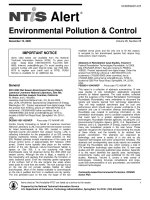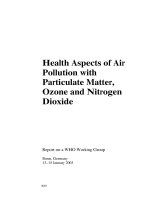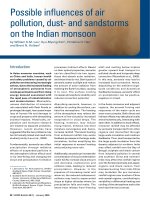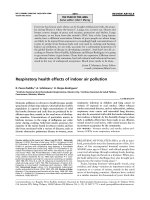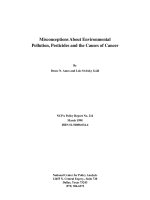BIOMONITORING OF ENVIRONMENTAL POLLUTION doc
Bạn đang xem bản rút gọn của tài liệu. Xem và tải ngay bản đầy đủ của tài liệu tại đây (377.6 KB, 10 trang )
UNESCO – EOLSS
SAMPLE CHAPTERS
PHYSIOLOGY AND MAINTENANCE – Vol. II – Biomonitoring of Environmental Pollution - Sergei Kotelevtsev, Valerii
Tonkopii and Osmo Hänninen
©Encyclopedia of Life Support Systems (EOLSS)
BIOMONITORING OF ENVIRONMENTAL POLLUTION
Sergei Kotelevtsev
Moscow State University, Moscow, Russia
Valerii Tonkopii
Russian Academy of Sciences, St. Petersburg, Russia
Osmo Hänninen
University of Kuopio, Finland
Keywords: ecosystem health, feral species, caged species, tissue cultures,
biotransformation enzymes, chaperons, heat shock proteins, estrogen-like pollutants,
mutagens
Contents
1. Introduction and Background
2. Biomarker Molecules
2.1. Genomic and mRNA Analyses
2.2. Proteomics: Enzymes and Other Proteins
3. Models Used in Biomonitoring
3.1. Cell Cultures
3.2. Tests with Invertebrates
3.3. Populations and Wild Vertebrates
3.4. Caged Organisms
4. Biomonitoring of the Quality of Air
5. Soil Pollution
6. Pollution and Biomonitoring of Water Resources
7. Biomonitoring of Textile Safety
8. Human and Animal Diseases in the Biomonitoring of Environmental Pollution
9. Attempts at Pollutant Bioidentification
9.1. Heavy Metals
9.2. Organophosphates
9.3. Organochlorines
9.4. Cyanides
9.5. Pyrethroids
10. Chemical Analysis of Pollutants and Biomonitoring
Glossary
Bibliography
Biographical Sketches
Summary
Environmental health is one of the most acute global problems. There are no corners of
the globe where chemicals produced by humans cannot be found. The number of these
chemicals is continuously increasing, as is their use. Some are quite persistent and their
half-lives can be decades. At the same time, the number of endangered species is
UNESCO – EOLSS
SAMPLE CHAPTERS
PHYSIOLOGY AND MAINTENANCE – Vol. II – Biomonitoring of Environmental Pollution - Sergei Kotelevtsev, Valerii
Tonkopii and Osmo Hänninen
©Encyclopedia of Life Support Systems (EOLSS)
increasing and people’s health is at serious risk. Lipophilic pollutants accumulate in all
organisms as they contain lipids. There are several methods of monitoring the effects of
pollutant chemicals. In addition to feral species, caged animals and plants, as well as
tissue and cell cultures, are used in studies of biomonitoring. The levels and activities of
enzymes responsible for the biotransformation of pollutants reflect the level of pollution,
if the organisms survive the pollutant load. For instance, the enzymes of the cytochrome
P-450 family are often highly induced in exposed organisms. Because the metabolism
of pollutants increases the production of oxygen-free and other radicals, the enzymes of
the antioxidant defense and repair systems become induced. The increased transcription
of respective genes can also be followed. Population studies indicate that pollutants
having hormonal activity have already changed the sex ratios in, for example, the
aquatic environment. However, the occurrence of diseases in humans is the ultimate
source of information on ecosystem health.
1. Introduction and Background
Industry, energy production, transportation, and intensive agriculture and silviculture, in
addition to municipal wastes, chemically load the environment. Rachel Carson was the
first person who directed the public’s attention to the pollution problem with her book
Silent Spring—birds were not singing any more—published in 1962. In addition, carbon
dioxide—very necessary for photosynthesis—is now considered one of the most
problematic pollutants, due to its excessive release, with other chemicals and particles,
from fossil carbon sources in energy production.
In Rio de Janeiro, in 1992, governments agreed on a Framework Convention on Climate
Change (FCCC), with the ultimate aim of reducing the level of greenhouse gases in the
atmosphere to safe levels. In Kyoto, in 1997, the world’s industrialized countries agreed
on reductions that they were committed to reach by 2008–2012. A number of countries
have already ratified the reduction plan. Without the Kyoto agreement the level of, for
example, carbon dioxide were predicted to increase by 20 µL L
–1
between 1990 and
2010. However, at the same time it has been estimated that the level would increase by a
further 15 µL L
–1
, due to production in developing countries. The warming-up of the
atmosphere, caused by the accumulation of greenhouse gases, would increase the
melting of the polar ice caps and therefore raise the sea level, with widespread
economic and social implications, not to mention the pollution by organic pyrosynthetic
chemicals—some of which are carcinogenic.
When people use wood for cooking and heating, they cut down trees, destroy forests,
and increase air pollution. When they make charcoal, they spoil the soil and ground
water too. In addition, they clear forest land for agriculture. Forests contribute to the
maintenance of a proper climate, clean the air, and also, by all these means, maintain
and promote biodiversity.
Carbon dioxide is bound to calcium to form inorganic calcium carbonate in the seas, but
this is a slow process. Carbon dioxide is used by plants and other carbon-fixing
organisms to synthesize organic compounds. Trees form an especially valuable sink of
carbon dioxide. One kilogram of wood removes about two kilograms of carbon dioxide
from the air, because oxygen is released to the same time. The use of wood for purposes
UNESCO – EOLSS
SAMPLE CHAPTERS
PHYSIOLOGY AND MAINTENANCE – Vol. II – Biomonitoring of Environmental Pollution - Sergei Kotelevtsev, Valerii
Tonkopii and Osmo Hänninen
©Encyclopedia of Life Support Systems (EOLSS)
that keep the carbon bound for a long time will help in maintain the proper carbon
dioxide balance in the atmosphere. It is important to design power plants that use
rapidly growing wood and other biomass, as well as capturing carbon dioxide in
addition to other pollutants in the burning process.
Air pollution is not only limited to carbon dioxide and other carbon compounds. The
level of small particles in the air—as well as the concentration of sulfur dioxide and
nitrogen oxides (NOX)—is exceeding the limits recommended by the WHO in many
large cities. The levels measured in many areas affect the health of plants, animals, and
human beings, especially children, and cancer incidences increase in affected areas.
Ozone is a commonly occurring pollutant that has a large impact on the yield of
agricultural crops. The dose response of crops in the field is complex, with influences
on numerous biotic and abiotic factors, including microclimatic variables. Ozone is also
one of the most important direct risk factors in human health.
Pollutants released into the air end up in rivers, lakes, and seas—the pollution of which,
by organic and inorganic compounds, continues globally. Radionuclides form a special
category of pollutants. There are sites where the safety limits are exceeded, due to
natural radioactivity, and there are sites where the radioactivity is high due to nuclear
experiments. Accidents in power plants and possible military or terrorist use represent
special categories of danger. A new, potentially problematic agent is electromagnetic
pollution. Telecommunication is increasingly widely used. The electromagnetic
pollution of the world has gained little attention so far. There are, however, examples
that indicate it also merits serious concern, because at least some organisms are
sensitive to it.
Figure 1. Schematic description of the food chain of a lake
UNESCO – EOLSS
SAMPLE CHAPTERS
PHYSIOLOGY AND MAINTENANCE – Vol. II – Biomonitoring of Environmental Pollution - Sergei Kotelevtsev, Valerii
Tonkopii and Osmo Hänninen
©Encyclopedia of Life Support Systems (EOLSS)
Biomonitoring is a regular investigation (registration) of behavioral, functional, and
morphological changes in organisms and their populations under the action of chemical,
physical, and ecological factors. Organisms form food webs and interact with each other
in many ways (see Figure 1).
The action of anthropogenic and nonanthropogenic factors should be studied. The main
aim of biomonitoring is to find out the responses caused by pollution and other factors
on living organisms in order to help decision making on ecosystem health problems.
Chemical pollution is usually divided into inorganic pollution (metals, acids, carbon
dioxide, nitrogen and phosphorus compounds, and ozone) and organic pollution, which
can further be divided into pollution due to persistent organochlorine compounds,
polycyclic aromatic hydrocarbons, phenols, phthalates, organometallic compounds, and
so on.
Lipophilic pollutants accumulate in all organisms as they contain lipids. There are
several methods of monitoring the effects of pollutant chemicals. In addition to feral
species, caged animals and plants as well as tissue and cell cultures are used in studies
of biomonitoring. The levels and activities of enzymes responsible for the
biotransformation of pollutants reflect the level of pollution, before morphological
changes take place.
Genotoxicity—factors such as mutagenic compounds and radiation, including
ultraviolet light—is perhaps the most important area of biomonitoring, because such
toxicity can cause carcinoma of somatic cells and/or harmful mutations of ova and
sperm cells, affecting the health of the next generation. The increasing content of
mutagens in aquatic products such as fish used in human nutrition accounts for the
necessity for monitoring genotoxic effects in coastal areas, especially in fisheries. Such
substances accumulating in animals not only modify existing ecosystems, but represent
a direct danger for man as well. Mutations are hereditary changes resulting in the
increase or decrease of the genetic material or in changes of chromosome structure or
DNA nucleotide sequences.
The increasing use of biomarkers in environmental biomonitoring programs has raised
the problem of data management and intercomparison. A research project—the
Pollution Effect Network (PEN)—has been proposed; it will entail the creation of an
online warehouse for biomarker data (see < The web
site will contain repository sections and expert system procedures able to integrate
information from different biomarkers and provide a ranking of organism health status
in terms of synthetic stress syndrome indexes.
2. Biomarker Molecules
2.1. Genomic and mRNA Analyses
Mutations arise both spontaneously and under the action of various factors such as
chemical substances, ultraviolet light (UV-B), or ionizing radiation. Aggressive
chemicals and the reactive metabolites produced from any chemical can act on the
UNESCO – EOLSS
SAMPLE CHAPTERS
PHYSIOLOGY AND MAINTENANCE – Vol. II – Biomonitoring of Environmental Pollution - Sergei Kotelevtsev, Valerii
Tonkopii and Osmo Hänninen
©Encyclopedia of Life Support Systems (EOLSS)
nucleic acids. DNA strand breaks occur. The reactive compounds also form DNA
adducts.
Chromosome mutations cause chromosome reorganization, including changes in
linkage groups (translocation), a sequence of changes within a chromosome (inversion),
fragmentation of chromosomes, and the loss of chromosome parts (deletion), as well as
a doubling of chromosome parts (duplication) or the inclusion of other genetic elements
into chromosomes (insertion). Point mutations are changes of DNA sequences at the
level of single nucleotides.
Genotoxicity tests can be classified according to the information they provide as follows:
• Chromosomal aberration tests: Eucaryotic in vivo and in vitro tests have been
developed. Aberration can often be detected by using a light microscope. A
cytogenetic analysis of structural disturbances of chromosomes in metaphase
and anaphase of mitosis, and a micronucleus test, are widely used.
• Recombination assays: In vivo and in vitro sister chromatid exchanges in
eucaryotic systems, as well as for reciprocal mitotic crossing-over and mitotic
gene conversion in yeast, are used in biomonitoring.
• Detection for dominant lethals can be made (e.g., on mice) and recessive
lethals on Drosophila.
• Single cell gel electrophoresis (SCCE) or comet assay provides valuable
information on the environmental pollutants affecting the genetic material in
individual cells.
• The micro array techniques: Polymerase chain reaction (PSR) helps in getting
small amounts of DNA multiplied for analyses, while differential display
techniques can be used to detect changes in the gene expression.
• The specific messenger ribonucleic acids (mRNA): The levels of mRNA
increase faster than the respective proteins in the cells. This method is not
sensitive to the possible inhibitory action of chemicals on the protein synthesis.
• Modified nucleic acid metabolites can be found even in urine.
• Gene (point) mutation analyses on microorganisms or cultured animal cells:
Assays for both direct and indirect mutations are used. The most common is
the Ames test, based on reversion to histidine prototrophy in Salmonella
typhimurium strains.
2.2. Proteomics: Enzymes and Other Proteins
One might expect the earliest responses to chemical or physical pollution would be seen
in the membrane functions of the cells, where many receptors and transporters are
located. Unfortunately, the measurement of these functions is technically difficult. The
membrane functions cannot change very much without lethal effects.
Pollutants are usually metabolized in organisms. These reactions are catalyzed by a
large group of enzymes (see Biotransformation of Xenobiotics and Hormones). The
measurement of the biotransformation enzymes, like that of the 7-ethoxyresorufin O-
deethylase (EROD), is rather easy. The amount of the enzymes can also be measured
UNESCO – EOLSS
SAMPLE CHAPTERS
PHYSIOLOGY AND MAINTENANCE – Vol. II – Biomonitoring of Environmental Pollution - Sergei Kotelevtsev, Valerii
Tonkopii and Osmo Hänninen
©Encyclopedia of Life Support Systems (EOLSS)
with the aid of antibodies. This also helps to quantify the enzymes that have been
inhibited by the pollutants.
Synthesis of the biotransformation enzymes is quickly induced by the exposure to many
pollutants (see Figure 2). The cytochrome P-450 and UDPglucuronosyltransferase
enzymes are good examples (see Biotransformation of Xenobiotics and Hormones).
Figure 2. The level of messenger RNA increases faster than that of the
biotransformation enzyme protein concentration and the 7-ethoxyresorufin O-deethylase
(EROD) activity in liver cell culture in the presence of inducer TCDD. The pollutant
may also cause an inhibition of the enzyme activity, and only the level of mRNA and
the enzyme protein amount reveals the increased enzyme synthesis. So, for instance, the
induction caused by the chemicals released by paper and pulp mills can be only partially
detected if enzyme activity alone is measured.
Source: modified from Pesonen et al. (1992).
In parallel with the oxidation of the pollutants, reactive metabolites and reactive oxygen
species are also generated. They interact with the proteins, lipids, and nucleic acids. The
proteins are carbonylated. The peroxidation of lipids also takes place. The unsaturated
fatty acids are split with the release of malone dialdehyde, which can quite easily be
measured, for example, in the blood (see Figure 3).
UNESCO – EOLSS
SAMPLE CHAPTERS
PHYSIOLOGY AND MAINTENANCE – Vol. II – Biomonitoring of Environmental Pollution - Sergei Kotelevtsev, Valerii
Tonkopii and Osmo Hänninen
©Encyclopedia of Life Support Systems (EOLSS)
The increased production of antioxidant enzymes, such as superoxide dismutase,
catalase, glutathione peroxidase, and glutathione S-transferase, can take place in cells
exposed to pollutants. Furthermore, the consumption of antioxidant cofactors, such as
the oxidation of glutathione, can be measured (see Figure 3).
Figure 3.
The pollutants can induce a biotransformation system (e.g., CYP =
cytochrome P-450, POX = peroxidase (plants), GST = glutathione S-transferase, UGT =
uridinediphosphate glucuronosyltransferase), antioxidant defense (e.g., GSH =
glutathione, SOD = superoxide dismutase), and repair systems (e.g., Hsps = heat shock
proteins or chaperons).
The cells have stress-proteins (also referred to as heat-shock proteins or Hsp—also
called chaperons), which can repair the destroyed functional conformation of the
proteins. Their induction occurs rapidly after an exposure to certain pollutants. Stress-
proteins have recently been recognized as being one of the primary defense mechanisms
activated by the occurrence of denatured proteins in the cell. The four major stress-
protein families of 90, 70, 60, and 16–24 kDa are the most prominent and are frequently
referred to as Hsp90, Hsp70, Hsp60, and low molecular weight stress-proteins. They are
highly conserved in all organisms from bacteria to plants and humans. However, more
knowledge on the kinetics and persistence of the stress response to complex
environmental mixtures, on the influence of both physiological and environmental
parameters (pH, eutrophication), on the constitutive levels of stress-proteins, and on the
acquisition of tolerance, is required before one could safely use stress-proteins to assess
on-site pollution. Nevertheless, as part of a test battery of complementary bioassays,
stress proteins may be very valuable as broad response biomarkers for preliminary
screening of environmental health (see Figure 3).
UNESCO – EOLSS
SAMPLE CHAPTERS
PHYSIOLOGY AND MAINTENANCE – Vol. II – Biomonitoring of Environmental Pollution - Sergei Kotelevtsev, Valerii
Tonkopii and Osmo Hänninen
©Encyclopedia of Life Support Systems (EOLSS)
The synthesis of metallothioneins and/or metallothionein-like proteins, which bind the
toxic heavy metal pollutants, is also induced in exposed cells. Vitellogenin proteins are
synthesized in the liver under hormonal control (e.g., in fish). If the pollutants interfere
with the synthesis, this can be detected with specific antibodies.
Usually a set of several proteins and other parameters are recommended for use in
biochemical biomonitoring of pollutant contamination problems. The next challenge in
method development is analysis of the levels of all the responding proteins in the cells
(i.e., the proteomics) when the cells are exposed to pollutants. This might also help in
the bioidentification of the most important pollutants.
3. Models Used in Biomonitoring
Many different models have been developed to help biomonitoring, both to increase
sensitivity and to save time and resources. Although much of the practical
biomonitoring has been transferred into laboratories, this does not make field studies
unnecessary. Sampling must always be guided by observations in the locations where
the pollution occurs.
-
-
-
TO ACCESS ALL THE 22 PAGES OF THIS CHAPTER,
Visit:
Bibliography
Bierkens, J.G.E.A. (2000). Applications and pitfalls of stress-proteins in biomonitoring. Toxicology
153(1–3), 61–72. [Heat shock proteins, also called chaperons, are able to correct the destroyed functional
structure of proteins. The level of these proteins increases, for example, due to pollutants.]
Carson R. (1962). Silent Spring. (Finnish edition (1970), 272 pp.) [This book opened a wide public
discussion in many countries and caused a change in thinking concerning the spraying of chemicals onto
fields and forests.]
Kopponen P., Asikainen M., Törrönen R., Klemola K., Liesivuori J., and Kärenlampi S. (1997). In vitro
cytotoxicity of textile dyes and extracts of dyed/finished fabrics. ATLA: Alternatives to Laboratory
Animals 25, 539–546. [Many colors used in textile industry are toxic at least in cell cultures.]
National Institute of Environmental Sciences (1996). Environmental Health Perspectives. 104,
supplement 4, 848 pp [Thorough discussion on the impact of air pollution on human health, research
needs for the risk assessment of health and the environmental effects of endocrine disruptors, male
reproductive health and environmental xenoestrogens, and chemically induced alterations in the
developing immune system—the wildlife/human connection.]
National Institute of Environmental Sciences (1998). Toxicological defence mechanisms. Environmental
Health Perspectives, Reviews in Environmental Health 106(1), 394 pp. [A series of reviews on various
aspects of environmental health.]
Pesonen M., Goksoyr A., and Andersson T. (1992). Expression of P4501A1 in a primary culture of
rainbow trout hepatocytes exposed to beta-naphthoflavone or 2,3,7,8-tetrachlorodibenzo-p-dioxin.
UNESCO – EOLSS
SAMPLE CHAPTERS
PHYSIOLOGY AND MAINTENANCE – Vol. II – Biomonitoring of Environmental Pollution - Sergei Kotelevtsev, Valerii
Tonkopii and Osmo Hänninen
©Encyclopedia of Life Support Systems (EOLSS)
Archives of Biochemistry and Biophysics 292(1), 228–233. [The mRNA precedes the synthesis of EROD
protein, which precedes the increase of active EROD enzyme.]
Richardson M. (ed.) (1996). Environmental Xenobiotics, 492 pp. London and Bristol: Taylor & Francis.
[A series of reviews on the fate of chemicals in the environment.]
Triebskorn R. and Köhler H.R. (ed.) (2001). Special Issue: VALIMAR–VALIdation of BioMARkers for
the Assessment of Small Stream Pollution. Journal of Aquatic Ecosystem Stress and Recovery 8(3–4),
161–425. [A set of articles concerning the aquatic pollution and possibilities to do biomonitoring.]
Viarengo A., Burlando B., Giordana A., Bolognesi C., and Gabrielides G.P. (2000). Networking and
expert-system analysis: next frontier in biomonitoring. Marine Environmental Research 49(5), 483–486.
[The standardization and pooling of data on the application of different biomonitoring methods is
necessary. The article makes a number of suggestions.]
Whyte, J.J., Jung R.E., Schmitt C.J., and Tillitt D.E. (2000). Ethoxyresorufin-O-deethylase (EROD)
activity in fish as a biomarker of chemical exposure. Critical Reviews in Toxicology 30(4), 347–570.
[Oxidation of pollutants is a common first step in the metabolism. Cytochrome P-450 family of enzymes
has a key role in these. Ethoxyresorufin is a useful model substrate to detect the induction of this enzyme
system.]
Biographical Sketches
Dr. Sergei Vasilievich Kotelevtsev was born in 1948 in Moscow, USSR. He studied at the Biophysics
Department, Moscow State University, School of Biology, Moscow State University, from 1966 to 1971,
obtaining his Ph.D. (Biophysics) with a thesis on Interrelation of Membrane Phospholipid Peroxidation
and Drug Metabolism in Livermicrocosms, in 1975. He was awarded his Doctorate of Science
(Ecotoxicology) for work on Response of the Biological Membrane to the Environmental Factors, at
Moscow State University in 1996.
He served at the Department of Biology, Moscow State University as: junior researcher, 1971–1979;
senior researcher, 1979–1992; and Deputy Chief of Laboratory of Physical Chemistry of Biomembranes,
since 1992. He has been Lecturer at the Department of Ecology Russian Peoples Friendship University,
Moscow, since 1992. He swerved as a Fellow of the European Science Foundation (Toxicology and
Environmental toxicology), Finland, in 1993.
His main fields of specialization include: metabolism of xenobiotics, radiobiology; other fields,
biomonitoring of drugs, and environmental health. He is currently researching: biochemical monitoring of
genotoxicity in water ecosystems; and mechanisms of xenobiotic biotransformation and the adaptation to
the chemical and radioactive contamination.
He is a member of the International Society for the Study of Xenobiotics, USA, and the International
Aquatic Ecosystem Health and Management Society. He was invited to lecture and participate at the
NATO Advanced Study Institute and Research Workshop “Molecular Aspects of Oxidative Drug
Metabolising Enzymes: Their Significance in Environmental Toxicology, Chemicalcarcinogenesis, and
Health,” Turkey, 1993; and at “Biomarkers: a Pragmatic Basic for Remediation of Severe Pollution in
Eastern Europe,” Poland, 1997.
He has produced 81 papers in refereed journals and 327 communications in scientific meeting, and is a
member of the Editorial Advisory Board of the Journal Aquatic Ecosystem Health and Management.
Dr. Valerii Tonkopii was born in 1939 in Donetsk, Ukraine, USSR. He studied at the Donetsk Medical
Institute, Russian Academy of Sciences and received his M.Sc. in1962. In 1968 he achieved his Ph.D.
(Hyperbaric oxygenation at different acute poisoning), and in 1981 his D.M. (the study of
anticholinesterase compounds toxic action), Doctor of Medicine.
In 1981 he became State USSR Prize Laureate (for the elaboration of organophosphorus poisoning
antidotes), and Professor of Toxicology in 1983. He served as a military-medical officer in the Military-
Medical Academy, Russian Academy of Sciences, 1962–1969; Senior Scientist Researcher: Head,
Laboratory of Toxicology, Military-Medical Academy (MMA), Leningrad 1969–1990; and has been
Head of Laboratory of Water Ecotoxicology, Institute for Lake Research, Russian Academy of Sciences,
UNESCO – EOLSS
SAMPLE CHAPTERS
PHYSIOLOGY AND MAINTENANCE – Vol. II – Biomonitoring of Environmental Pollution - Sergei Kotelevtsev, Valerii
Tonkopii and Osmo Hänninen
©Encyclopedia of Life Support Systems (EOLSS)
St. Petersburg since 1990. His research fields are: indication of highly toxic compounds and the
elaboration of anticholinesterase inhibitor antidotes, and the development of nontraditional methods for
xenobiotic bioidentification on the basis of toxic action mechanisms.
His teaching career includes work as: visiting lecturer in Military-Medical Academy and Institute of
Toxicology, Leningrad; lecturer at the University of Helsinki (June 1993) in the Biological Institute of the
University of Oslo (May 1994), and the US Army Medical Research Institute of Chemical Defense
(Edgewood, USA, November 1994).
He has produced more than 300 publications and has participated in 50 international conferences and
workshops.
Dr. Osmo Otto Päiviö Hänninen D.M.S. Ph.D., is Professor of Physiology, and Department Chairman
at the University of Kuopio, Finland. He was born in 1939 in Lahti, Finland. He studied at the University
of Helsinki and the University of Turku, Finland, where he received his M.Sc. (Biochemistry) in 1962;
Licentiate of Medicine (MD), 1964; and Doctorate of Medical Sciences (DMS), 1966; and passed his
dissertation in biochemistry for his Ph.D. in 1968. He has also studied genetics. He has been a specialist
in sports medicine since 1986. He served as the Research Assistant of Professor K. Hartiala, 1962–1964;
Assistant of Physiology, 1964–1965; Laborator of Physiology, 1966–1967; Docent of Physiology, from
1967, and Associate Professor of Biochemistry, 1969–1971, at the University of Turku; Acting Professor
in the Planning Office, 1971–1972; and from 1972, Professor of Physiology and Chairman of the
Department of Physiology, University of Kuopio; Vice-President of the University of Kuopio, 1972–1979;
and President, University of Kuopio, 1981–1984. In addition, he served as Visiting Professor of
Physiology at Shanghai Medical University, China, 1991–1992, and at Sun Yat Sen Medical University,
Guangzhou, China, 1998–1999; as Foreign Member of the Russian Academy of Natural Sciences, from
1994; and as Secretary General, International Council for Laboratory Animal Science, 1988–1995. He
was the President of Societas Physiologica Finlandiae, 1990–1999, and has been President of the
International Society for Pathophysiology and a Member of the Executive Committee since 1994, and the
Treasurer of the International Union of Biological Sciences since 1997.
His special interests in research are: biotransformation and adaptation to chemical loading, biomonitoring
of toxicants, and comparative biochemical toxicology; muscle metabolism and function; ergonomics.
He has contributed 266 papers in refereed journals and 72 in proceedings, and written 55 reviews and 30
books or book chapters. He serves on the editorial board of four international journals and is at present the
European Journal Editor of Pathophysiology.
Of his postgraduate students (32 in biotransformation, 27 in muscle metabolism and physiology, and five
others), 12 serve as professors in China, Finland, Greece, Sweden, and the United States.


